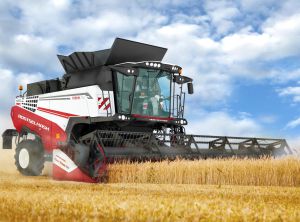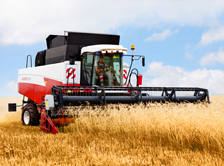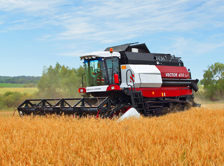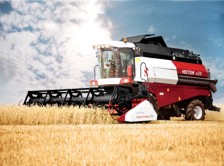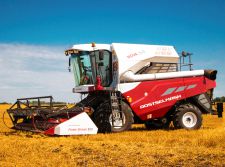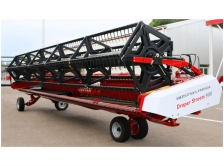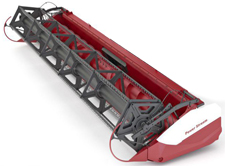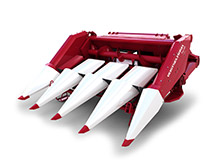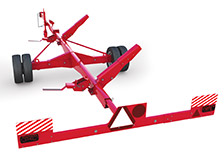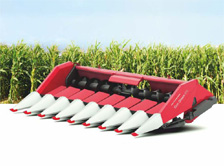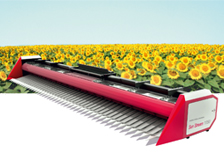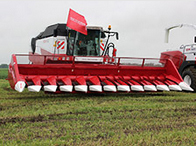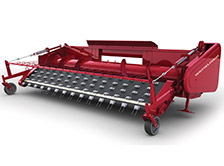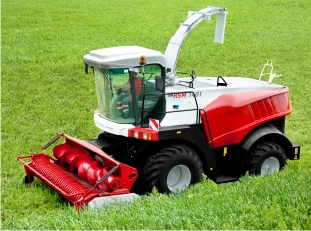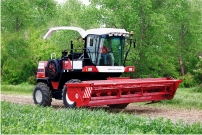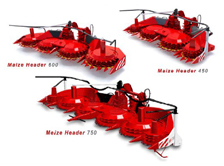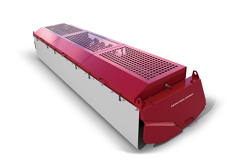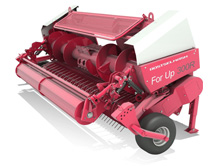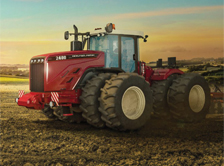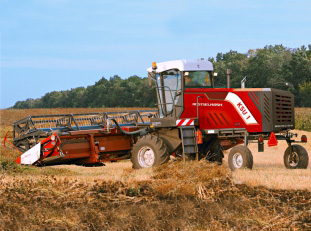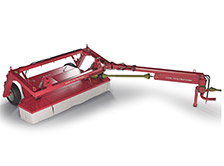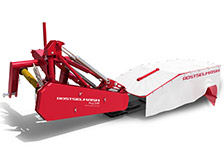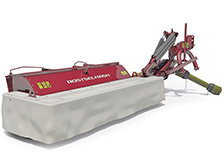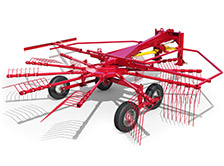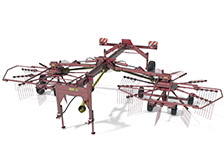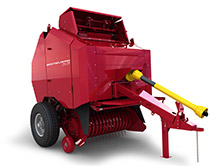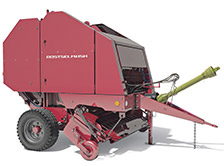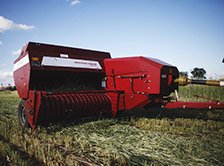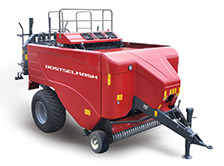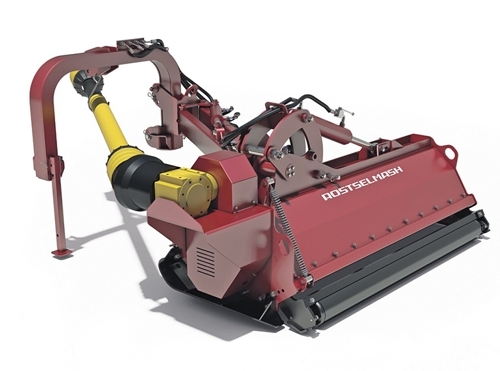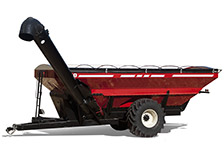Peace. Labour. Rostselmash
_5ea6670739c9d.jpg)
There are hundreds of award-winning achievements in the history of Rostselmash. There are specific people behind each of them. They made history, in honour of the 90th anniversary of the company we will tell about the employees who received the title of Labour Hero at the enterprise, and about the key moments in the history of the company that made it a leading manufacturer in the agricultural machine-building industry.
Order Bearer Rostselmash
Since 1938, the outstanding work of USSR citizens began to be celebrated with a special award comparable in importance to the Gold Star of the Hero of the Soviet Union - the Gold Medal "Hammer and Sickle", which was awarded to the Heroes of Socialist Labour. The official text of the award regulation stated that it was assigned to persons “who, through their particularly outstanding innovative activities [...] showed exceptional merit to the Soviet state, contributed to the rise of the national economy, science, culture, the growth of power and glory of the USSR”. In general, the reward was the domain of the privileged. Eight people at Rostselmash became labour heroes at different times.
The enterprise itself, like its employees, also received many awards, but three of them are considered to be the key ones: the Order of the Red Banner of Labour (1930), the Order of Lenin (1956), and the Order of the October Revolution (1971). The wording of the award sheets of those years is quite elliptical, but it’s worth a little effort to understand what titanic work is behind each of them.
In 1930, Rostselmash received the Order of the Red Banner of Labour for the early launch of production. Noteworthy is the resolution of the Supreme Council of the National Economy of the USSR of August 1, 1925, justifying the creation of a new agricultural machine-building enterprise: “In view of the fact that the Southeast represents a huge market for the sale of agricultural implements [...]. To recognize that Rostov-on-Don in the future should become one of the main places of agricultural implements production, as it occupies an advantageous position in the sense of marketing products and supplying raw materials, the availability of skilled labour and technical personnel, and, in addition, as a large political and industrial centre". So, in essence, the further development of Rostov-on-Don was determined at the stroke of a pen: the creation of a new enterprise in the future required the construction of a whole suburban village, which later became the centre of the Pervomaisky (Stalin) city district.
The construction of the shops of the future enterprise began in the second quarter of 1926, it was scheduled for five years. While the project was being approved, work was already in a full swing in the area of the Nakhichevan-Donskaya station: access roads and temporary auxiliary facilities were under construction. Industrial construction started in the second half of 1927. Just two years later, in July, the first five of the 18 designed workshops were commissioned, and on July 21, the company produced the first batch of horse-drawn carts. This day is considered the birthday of Rostselmash. The construction period was unprecedented even by today's standards.
The first combine harvester named “Kolkhoz” was released by Rostselmash a little later - on June 30, 1930. This date is less known, however, it can be considered one of the main dates in the calendar of national agricultural machinery construction.
New achievements and the first Labour Heroes
In 1956, Rostselmash received the Order of Lenin. As it was said in the award sheet, “in connection with the 25th anniversary of the full commissioning”. But it was not only the anniversary to be awarded. By that time, the enterprise had become a leader in equipping domestic agriculture with new equipment. At the end of 1955, preparations began for the release of a new harvesting machine – “Rostselmash 8” combine harvester (RSM 8). Like Stalinets 1, as well as Stalinets 6, it was developed by own designers, but it exceeded its predecessors in basic parameters. It had a greater throughput of the threshing mill (4 kg/sec versus 2.5 for Stalinets 6), a more powerful engine (52 hp versus 40 hp) and a header width (6 m versus 4.9 m). RSM 8 was produced for a little over a year (December 1956 - January 1958), with releasing 50 thousand units during this time. With discontinuing PCM 8 release, the era of trailed agricultural machines ended and the era of self-propelled harvesters began.
Six years in the USSR, i.e. from 1954 to 1960, were marked by virgin land development - an unprecedented set of measures that covered most of the country. Land ploughing in Kazakhstan, the Urals, Siberia and the Far East was performed at high speed: over the years of development 41.8 million hectares of virgin lands and deposits have been opened up. In 1954 alone, the country's industry supplied agriculture with 137 thousand general-purpose tractors and 37 thousand grain combine harvesters. Thus, almost 88% of ploughing tractors and more than 25% of combine harvesters produced in the country were sent to virgin lands. To supply such a huge amount of equipment capable of serving giant spaces in harsh conditions, it was necessary to establish a high-quality uninterrupted production. High achievements were required from the workers of such an enterprise. It was at this time when the first Heroes of Labour appeared at Rostselmash.
The first Rostselmash worker, who received a high award, was a coremaker, the foreman of a women crew of the malleable iron workshop – Nina Drobysheva. She worked at Rostselmash from 1950 to 1976. Here she mastered a completely non-female profession of a moulder. In 1952, she became a foreman of the core-making site. In 1958, she was the leader of a women crew, which achieved high performance and was one of the first in the Rostov region to receive the title of “Communist”. In 1960, Nikita Khrushchev, Chairman of the Council of Ministers of the USSR, personally congratulated Drobysheva on conferring the title of Socialist Labour Hero.
Launching a new self-propelled combine harvester, SK 4, was in full swing at Rostselmash in the 1960s.
For its creation, a team of designers led by Hanon Izakson was awarded the Lenin Prize. This machine has been recognized as the most awarded model among combine harvesters. In those years, Peter Faustov worked as a machine fitter and a test engineer at Rostselmash. He came to the production in 1951. During his work, he repeatedly travelled abroad to help in mastering new techniques. His practical recommendations allowed to create one of the best combine harvesters of its time, which lasted on the assembly line from 1962 to 1974. He received the title of Socialist Labour Hero in 1966 for "special merits in fulfilling the tasks of the seven-year plan and achieving high performance indicators". The seven-year plan for national economy development (1958-1965) implied the rise of all economy sectors, raising the standard of living of the population.
Niva creation and millionaires time
In 1971, Rostselmash was awarded the Order of the October Revolution for successes in equipping agriculture with grain-harvesting equipment, this is another high award of the Soviet era. Two years before this landmark event, in 1969, Rostselmash produced a millionth harvester. It was SK 4, already known in the country and far beyond its borders. The achievement, of course, was outstanding, however, the real reason for such a high appreciation of merit lies in the creation of a new combine harvester, the first experimental samples of which were released in 1970 – SK 5, which got the name "Niva". In 1971, Rostselmash was declared an All-Union Komsomol shock-construction project within the framework of Niva production preparation. Due to design simplicity and reliability (the result of a deep modernization of the “60s hit” SK 4), this machine became a brand identity of Soviet engineering and the most massive Soviet combine harvester (more than 1.2 million units of this equipment produced), which were produced in various modifications until 2018.
In the same 1971, Dmitry Efimov, senior foreman of crankshaft hot bending section of the first mechanical assembly shop, was awarded the title of Socialist Labour Hero “for special merits in fulfilling the tasks of the five-year plan for agricultural engineering development”. He worked for Rostselmash starting 1948 (he was a turner, adjuster, foreman). As remembered by his colleagues, this was one of the most responsible and goal-oriented people at the enterprise. His talents were especially revealed in finding ways to increase labour efficiency. It was him who initiated the introduction of forecasting and planning method of creative economic plans. The initiative was then in demand at other enterprises of the country.
Another Hero of Labour in 1974 was Maria Novikova. She worked at Rostselmash since 1955, mastered seven specialties for working with machines. She was a turner, a crew foreman. During her work, she could operate five machines, replacing the work of ten people. She received the title of Socialist Labour Hero "for outstanding success in the implementation and over-fulfilment of 1971 plans". In October 1982 she was transferred to Rostselmash as an industrial training foreman at vocational school No. 1.
80s: the Dawn of the Soviet Rostselmash
In the beginning of the 1980s, Rostselmash faced one of the most dynamic periods in its history, which largely determined the modern look of the enterprise. It is no coincidence that this decade was marked by the appearance of four Heroes of Labour at once. Some of them have become the legends of agricultural machinery. Let's move step by step.
In 1981, the honorary title of Socialist Labour Hero for outstanding production achievements was awarded to mechanic Konstantin Ulanov. He came to Rostselmash to a combine harvester workshop back in 1956, to which, by his own admission, he had love since childhood. At the initiative of Ulanov, the chassis assembly section was the first at the production to work under the motto "Work without underperformers". His daily productivity standard was 140%.
In 1983, Petr Kolesnikov, Rostselmash planer, was awarded the title of Labour Hero. He was distinguished for his good results in fulfilling planned targets and "a great contribution to raising worthy successors". By that time, he had been working at Rostselmash for 52 years, was one of his pioneer builders. In the 1950s, he worked on three machines, was the initiator of high-performance techniques for processing metal parts. Twice he represented Rostselmash at VDNH, where he demonstrated advanced working methods of a planer. He fulfilled productivity standards 300-400%.
A year later, in 1984, Labour Hero was received by a Rostselmash grinder Zinaida Eremenko. She was awarded the prize for outstanding successes "achieved in fulfilling production tasks, socialist obligations and increasing labour efficiency". She worked at the enterprise in the mechanical assembly shop No. 1 since 1952. He mastered five related professions: grinder, borer, specialist in broaching, turner, adjuster. In 1981, due to workshop reconstruction, she was transferred to the mechanical assembly shop No. 4.
In 1986, Director General of the enterprise, Yuri Peskov, became the Hero of Labour. The official wording is: “for outstanding production achievements, early fulfilment of the 11th five-year plan tasks and merit in domestic agricultural machinery development and the manifested zealous labour”. He was the head of the company from 1978 to 1996. During this time, production has undergone a real revolution, which largely determined the leading position of Rostselmash in the domestic market and one of the leading positions in the global market. In the early 1980s, Rostselmash began developing and producing highly efficient combine harvesters of the “Don” family. This was the seventh transition of the enterprise to the production of new machines.
The production of the Don combine harvester required 1,460 items of components that were either not produced in the country at all, or were manufactured at the institutes in minimum experimental lots. It was necessary to orient 33 ministries out of 53 existing in the country towards the implementation of the “Don 1500” program. Therefore, Peskov was promoted to the rank of Deputy Minister of Tractor and Agricultural Engineering of the USSR.
In fact, an entire cluster for the production of agricultural machinery was created in the 80s at the premises of Rostselmash. Yuri Peskov diversified this production - he took the production of headers, forage harvesters to the enterprise. In February 1984, the two millionth combine harvester left the main conveyor of Rostselmash, and in October 1986, the first “Dons” were put into serial production.
Modern Rostselmash is a Top-Rank Enterprise
In the 90s Rostselmash experienced many shocks, but in 2000, with the advent of a strategic investor (the industrial union «Novoye Sodruzhestvo»), the enterprise got rolling with renewed vigor. Product line has been completely updated, advanced production, administration and management technologies have been introduced. In 2004, VECTOR 410 was launched in production, and in 2005 - ACROS 530.
Today, the Rostselmash group of companies includes 13 enterprises located at 10 production sites in 5 countries that produce equipment under the ROSTSELMASH and VERSATILE brands. The company's product line includes more than 150 models and modifications of 24 types of equipment. 80% of the bread of the Russian Federation is harvested by the company’s combines.
Rostselmash today is a manufacturer with a worldwide reputation. Despite the change in the economic and the political system, the enterprise shows that its potential, unlike for many other Soviet giant enterprises that have sunk into oblivion, is still in demand. This is a considerable merit of the first generations of Rostselmash builders and workers, who laid the foundation of a world-famous enterprise and passed on the genes of leadership and invention to subsequent generations.


